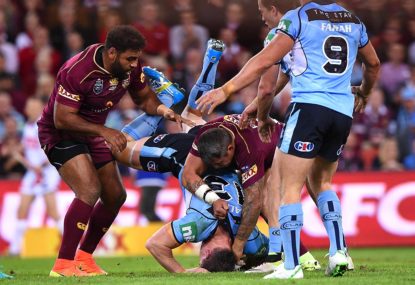Most NRL fans are confounded by the inconsistencies in the grading of charges laid by the match review committee (MRC), and the penalties handed out by the judiciary.
How does Tyson Frizell get one week for touching a ref, while others get off scott free?
Ryan James gets a week for breaking James Tedesco’s jaw, while Charlie Gubb gets rubbed out for seven weeks (albeit with loading and losing the early plea discount) for a shoulder charge that didn’t make head contact or injure anyone.
Josh Reynolds doesn’t miss anything for a trip, while Josh Hodgson gets only a week for trying to twist Jesse Bromwich’s head off.
There’s seemingly no system, no transparency and as a result no consistency. Instead of a systematic, objective approach, punishment is determined by sympathetic ex-footballers, as determined by the NRL Judiciary Code of Procedure.
Firstly, the NRL needs to determine what they see as the worst offences in the game and then build a scale of punishment that reflects that. People will disagree and say that a shoulder charge is worse than a swinging arm or vice versa, but if the NRL is consistent and transparent in their approach it reduces the arguments and the lack of understanding.
As an example, Gubb’s suspension is one of the lengthiest this season. Is the NRL seriously telling us that a shoulder charge that doesn’t make head contact is five times worse than a swinging arm head-high that breaks someone’s jaw?
The offences don’t compare and the penalties are completely out of whack.
High tackles have 15 potential gradings – careless grades 1-5, then reckless, then intentional. Does anyone really believe there are 15 levels of high tackles?
James’ tackle on Tedesco and Martin Taupau’s tackle on Jack Bird this year, which knocked him out, were both grade 2 careless tackles. In other words, there are 13 worse gradings. A grade 5 reckless must need to send a player’s head sailing through the goal posts.
There’s no need for this many gradings, particularly when they include the abstract concept of determining a player’s intent.
Introducing consistency in charging and sentencing is pretty simple. Most dangerous acts on a football field have comment elements that make reflect their severity.
For lifting tackles I’d suggest the elements would be:
1. The attacking player is lifted and goes past the horizontal
2. The player lands on his head or neck
3. The defender lifting with his arm between the legs
4. Lifting occurring after the player’s momentum has stopped
5. The lifter being the second or third man into the tackle
6. The defenders drive the attacking player into the ground
7. The tackled player suffers an injury
The grading of the charge then gets based on how many of these elements exist within a tackle.
So, the least offensive lifting tackle looks like this: a player lifts in a one-on-one tackle but he doesn’t have an arm between the legs or drive the opponent into the ground. The ball carrier is still moving forward when he’s tackled, lands on his back and doesn’t suffer an injury.
This is deemed an illegal lifting tackle because the ball carrier goes past the horizontal, but it doesn’t have any of the other elements to make it ‘dangerous’, so it’s deemed penalty sufficient when reviewed.
A tackle where the player does land on his neck, there was an arm between the legs, and the lifting commenced after the forward momentum stopped, gets say a grade 3 and 300 points.
So on, up to a tackle that contains all of the above elements, which gets the highest grading and penalty. We can be assured that is the worst sort of lifting tackle, and deserves a lengthy stint on the sidelines.
With a little bit of planning, you’d end up with a systematic approach and complete transparency, which should lead to consistency in grading and consistency between the MRC and the judiciary.
The same can be done for high tackles:
1. Attacking player falling in the tackle
2. Defender coming in with a swinging arm
3. Contact with the head
4. Initial contact with the head
5. An injury is caused
You can do it with any charge. Just have up to five or so gradings, with a transparent and consistent set of markers that pre-determine the grading. Then pre-determine penalties for each grading, which reflect the severity of the charge and reflect the NRL’s position on the worst offences in the game.
Things like early plea discounts (which should increase because gradings will be harder to argue) and loading can then be worked into the penalty.
I’d take comfort in a system like this, where I could look at a tackle and say, “Yep, that’s definitely a grade 2 and will definitely attract two weeks”, instead of the lucky dip that comes with seeing how a charge is graded and then penalised.





























































































